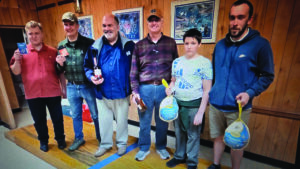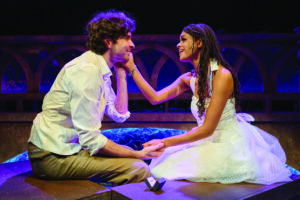 Moving Pictures: American Art & Early Film
Moving Pictures: American Art & Early Film
Through May 20 at the Phillips Collection, 1600 21st Street NW, Washington, DC. Museum Hours: Tuesday through Saturday 10 a.m. to 5 p.m., Thursday 10 a.m. to 8:30 p.m., Sunday Noon to 6 p.m. (202) 387-2151, or see www.phillipscollection.org
”Moving Pictures” is tightly focused on the nascent days of movies, and their influence in the arts. Thanks to technological advances over the past few years, we are now able to see these films displayed in the galleries on flat panel screens juxtaposed with paintings and graphics of the same era. It’s an interesting presentation, and certainly helps to put things in historical context.
These juxtapositions seem to pit photography against rendered media once again, with no clear victor. Sometimes the primitive black and white movies are more fascinating, and at other times less so. In some cases, such as the waterfalls and roiling ocean footage, both versions can hold their own.
 A sort of conundrum brews under the surface. We are shown what amounts to the conception of this new medium, and with it’s juxtaposition to traditional media there seems to be an implication of cross-pollenization influence. However, without prior reference (the “before” picture, if you will) we can’t draw any definitive historical conclusions there of. If there is an over arching point of this sort being made, it literally gets lost in the mix. On the other hand, the idiosyncratic nature of painting in general would make this hard to pin down anyway.
A sort of conundrum brews under the surface. We are shown what amounts to the conception of this new medium, and with it’s juxtaposition to traditional media there seems to be an implication of cross-pollenization influence. However, without prior reference (the “before” picture, if you will) we can’t draw any definitive historical conclusions there of. If there is an over arching point of this sort being made, it literally gets lost in the mix. On the other hand, the idiosyncratic nature of painting in general would make this hard to pin down anyway.
The one area we can unequivocally draw such conclusions is in the depiction of horses. Keeping in mind that 1880 to 1900-ish was pre-automobiles, so horse art was the norm for virtually any sort of transportation or military image. If you can’t draw a horse you have a problem. Enter photographer Eadweard Muybridge. Muybridge it could be argued invented the moving picture around 1884 when he lined up a series of still cameras with triggers set to go off as a horse ran by. What resulted was nothing short of a revolutionary display of equine bio-mechanics, and the world as we know it has never looked the same since.
Paintings of horses in motion pre-Muybridge could best be summed up as daft depictions. Even armed with this irrefutable photographic evidence, artists refuted it, for a while. Frederic Remington, an early convert, was caught straddling the fence around 1890. To our modern eye, the mechanics of those images look more like bunny rabbits than horses. Still, it was a move in the right direction. The critics protested against the ‘too real’ Muybridge inspired depictions which seemed to freeze time and motion, in favor of the stylized status quo, which they argued showed the spirit of the horse in motion. Today those stylized images look more like horses on ice clamoring for footing. Of course the equine artists came around in time, but the argument was fairly humorous. Doubly so if you take into account the battle waged by the impressionists decades before in favor of their fuzzy focused images that implied motion and an expanded slice of time, against the staid realistic Academy artists. Go figure.
Improvements in photographic film speed (which allowed for shorter exposure times, and thus could finally freeze movement in photos) suddenly allowed for a series of photographic images to be shown in rapid succession and thus the ‘movie’ as we know it was born. Subject matter of the day was predominately simple footage of life and the world around them. Pretty simple to us 100 years later, all new to them at the time. More than anything else, this sense of visual naivete drives home the point of how differently we look at the world around us since the advent of photography in general.
Notable exceptions for me were two films of swirling dancers with flowing robes, which often completely hid the dancers. “Danse Serpentine” and “Crissie Seridan” (both circa 1897) look like flowers opening and closing, mobius strips in motion, flowing whirling abstractions that captivate and hold the eye even to this day. One can only imaging the effect they must have had a hundred plus years ago. “Moving Pictures” is a rare opportunity to see the genesis of the preeminent communication medium of our age.
Of special note: Gallery talks on Thursday evenings are at 6 and 7 p.m. April 12 the subject is ‘Teaching the Light to Dance- Loie Fuller and the Serpentine Dance’, and then on May 17 the subject will be “Freeze Frame- Eakins, Muybridge and Serial Photography.” See web site for full listings of scheduled events for each week.
Artist Opportunities
Del Ray Artisans Member Show
Drop off of up to three works Friday, April 6 from 6:30 to 8 p.m., and Saturday, April 7, from 10 a.m. to 1 p.m. Show runs from April 13 through 29. Every member gets one piece in the show, with multiple entries on a space available basis. Membership is $35 for the year, or $10 for students, seniors and the disabled. Now for the kicker, if you are a member of the Del Ray Artisans, or the Art League in the Torpedo Factory, or the Springwater Fabric Workshop. You get to enter the Art in City Hall (Alexandria) show that runs from April 18 to September 14. The City Hall show drop off is April 14, and a two dollar fee for each entry up to three. Cash awards determined by the juror, Norman Parish, owner of Parish Gallery in Georgetown, the preeminent African American art Gallery in Washington. See www.thedelrayartisans.org for complete details and forms. Click on “Calls For Entry.”
Visual Rhythms / Ritmos Visuales
An all media juried art show embracing the flavors and rhythms of Latin American influenced art. Entries must be received by Friday, May 4. Up to three entries for $30 via jpg images on CD. A new twist on the old order. Additional $5 fee for slide submissions. Slide submissions are dying out fairly quickly it seems. Target Gallery at the Torpedo Factory Art Center, 105 North Union St., Alexandria Gallery hours Noon to 5 p.m. Wednesday through Sunday, and Thursday May 11 from 6-9 p.m. (703) 838-4565 (extension 4), or see www.torpedofactory.org.
Auditions ‘Kin, the Trial of Carrie Buck’
Sunday, March 31, from 10:30 a.m. to 1:30 p.m., and Monday, April 2, from 7 to 10 p.m., at the McLean Community Center, 1234 Ingleside Ave., McLean, Va. Looking for seven men and six women ages 18-60, one four-year-old girl, and three a capella singers to double with acting roles. Southern Accents Required! Performance dates are June 8-10, and dates TBA. For further information call Patti Green Roth at (703) 609-5141, or see www.sundialtheatre.org.












